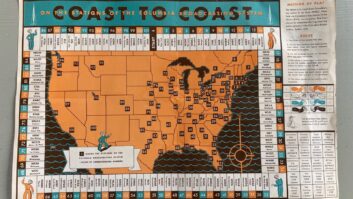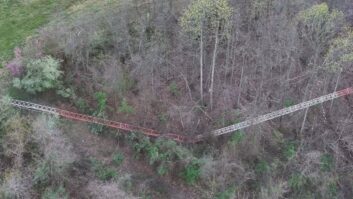SPRIMONT, Belgium — In April, French-language independent broadcaster Radio Ourthe Amblève finalized its studio upgrade.
The station’s goal was to put together a futureproof radio studio to allow ROA to stand out from the crowd in the south of Belgium’s busy, private radioscape. To do so, it opted for an atypical, yet effective, Wi-Fi bridge for signal transmission between the on-air studio and the antenna, and a revamp and consolidation of its two studios into one modern facility.


ROA President Marcel Kerf in the New On-Air Studio
LOCAL CONTENT
Founded some 33 years ago as a private commercial radio station, serving “la porte des Ardennes” (“the gateway to Ardennes”), the Liège region in the Belgian French-speaking community.
The station, operated by the nonprofit organisation ASBL Radio Ourthe Amblève and mainly financed by on-air advertising, broadcasts on 106.2 FM and via the Internet. With an an antenna output power of 100 W, ROA covers a 20 kilometer radius.
Located in a school-building in Sprimont, the station’s team of 15 volunteers broadcast live programs between 8 a.m. and 10 p.m each day. News bulletins are provided by a central news service, while local associations supply the socio-cultural content and events agenda.
“ROA has always been an independent local broadcaster,” said Marcel Kerf, ROA president. “All of the work is done by volunteers, in the true spirit of a nonprofit organization. With some 30 commercials per day, clustered in advertising blocks every 15 minutes, we make the station economically viable, allowing us to make the necessary investments.”
The community of Sprimont lets the station use one of its buildings, provided the broadcaster handles all infrastructure and energy costs — “for a major refurbishment like the one we just completed, we had to get permission from the local authorities,” adds Kerf.

The New On-Air Presenter Area
The station made the decision to upgrade its technical facilities in November 2014. “The on-air studio was equipped with an older Dateq BCS 500 mixing console for which servicing and spare parts were no longer available. For some time, our signal also suffered from interference, caused by transmission issues between the on-air studio and the transmitter,” he said.
LIMITED BUDGET
“We were paying a telecom provider €160 per month for a low-quality data link transmission line,” said Marina Penasse, ROA administrator. The station’s location, in the middle of the countryside surrounded by trees created a transmission challenge for ROA.
Initially, the station’s on-air landscape consisted of one main analog broadcast studio with a glass wall separating the technical department from the actual on-air studio. “As a nonprofit organisation we had a limited budget for the upgrade,” explains Penasse.
“The two options were either to continue in analog and replace separate components or to transition to a completely digital airchain from console to the final transmitter. We opted for the latter, and a budget of some €50,000.”
ROA appointed WNM Audiovisual Solutions to take on the design and integration of the new studio. A team of two technicians and a sound engineer handled the entire set up, engineering and cabling in less than three weeks.

At the heart of the new studio is an Axia iQ8 eight-fader console and an Axia iQ6 telco expansion frame.
The core of the new studio is an Axia QOR 32 featuring a mixing engine, all audio inputs and outputs, CPU and an Ethernet switch in one rackmounted box. The work desk consists of an Axia iQ8 eight-fader console plus an Axia iQ6 telco expansion frame — the telco section controls a Telos iQ6telephone hybrid gateway.
“We have nearly used the full capacity of the core and the power of the Livewire AoIP protocol. One of the benefits of working with the Livewire network is the option to monitor every step of the workflow. In case of a failure in the chain this allows the possibility of responding quickly where necessary,” said Baptiste Mohr, WNM project manager. “We also put in place a DEVA Broadcast DB9000-TX IP audio encoder and the DB9000-RX IP audio decoder.”
UNUSUAL SIGNAL TRANSFER
ROA also transitioned from a two-room studio to one spacious on-air studio. “The original concept wasn’t functional and we decided to move to a single room to improve proximity and communication — the whole technical team now takes part in the show. And there is room for studio guests.”
“The complete area was acoustically redesigned and we renovated the walls, ceiling and door,” continued Penasse. “A guest table for interviewees was equipped with five new Audio-Technica AT4033 microphones.”
As part of the upgrade, ROA also implemented Wi-Fi technology to establish the connection between the on-air studio and the actual location of the DEVA Broadcast transmitter and MHz antenna, located some 500 meters away on a water tower on a hill.

The new spacious upgraded ROA on-air studio, which was
once designed as a twin studio, features an interview table.
“All of the audio signals are routed back to the Axia QOR 32. Even the Omnia One antenna processor’s output is returned to the Axia QOR 32, allowing us to monitor the broadcast signal,” explained Mohr.
“The QOR 32’s on-air output is then routed to the DEVA Broadcast DB9000-TX AoIP encoder and the Wi-Fi antenna. A Wi-Fi receiver, also on top of the water tower, then picks up the signal — the DEVA Broadcast DB9000-RX AoIP decoder subsequently decodes the signal and sends the output to the RVR FM 500 transmitter and Aldena antenna,” he said.
Mohr admits that the technology may not be very typical but points out that in this case it’s very effective.
FLEXIBILITY
“For technical backup and to ensure the continuity of ROA’s broadcasts, the DEVA BroadcastDB9000-RX is equipped with an SD memory card containing two hours of program content, in a loop.”
“In the case of technical problems we have access to the air chain path from WNM offices,” he said. Mohr cites a recent example, where he used the specific remote software to check the DEVA Broadcast DB9000-TX AoIP encoder’s signal loss. “It turned out that one of the ‘mute’ switches on the console was on …,” he said.
“In addition,” adds Mohr, “the DEVA Broadcast DB9000-TX AoIP encoder allows ROA to transmit the whole IP signal, audio and dynamic RDS, in the same flow, instead of having separate feeds. This facilitates monitoring, access and maintenance,” he says.
The station inaugurated its new on-air studio last spring. “A key element in our decision was to have the option to expand the basic set-up in future, making the whole configuration flexible and future-proof,” concluded Kerf.
Marc Maes reports on the industry for Radio World from Antwerp, Belgium.










